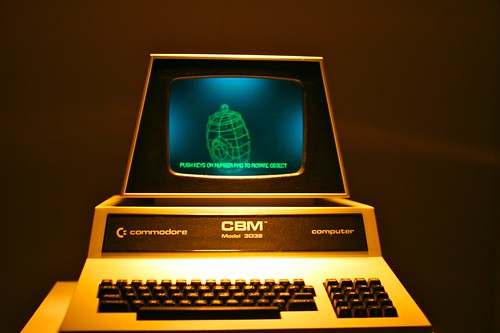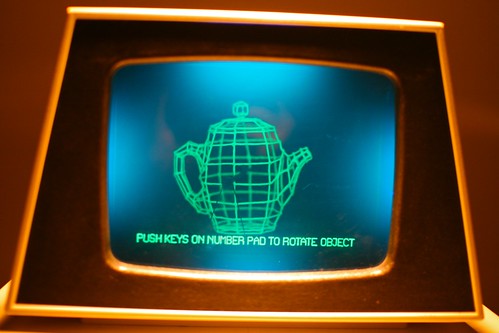 Grafikdemo by Niklas Roy is another interesting project I stumbled across in Basel two weeks ago. The set-up is pretty basic: it consists in a physical wireframe model of a teapot included inside a Commodore CBM 3032 cabinet. The user/viewer can rotate the model by pressing some keys on the keyboard. As formulated by the artist, "Sophisticated lighting of the model makes it hard for the viewer to distinguish whether he sees a real digital model or a fake computer screen".
Grafikdemo by Niklas Roy is another interesting project I stumbled across in Basel two weeks ago. The set-up is pretty basic: it consists in a physical wireframe model of a teapot included inside a Commodore CBM 3032 cabinet. The user/viewer can rotate the model by pressing some keys on the keyboard. As formulated by the artist, "Sophisticated lighting of the model makes it hard for the viewer to distinguish whether he sees a real digital model or a fake computer screen".
This project hence "explores the transition between reality and representation in a playful way" and the choice of a teapot is definitely not fortuitous: ""The decision of using a teapot as wireframe model is a result of this object’s outstanding importance in computer animation history".

In an interview, Roy explained:
"My intent was simply to create a physical copy of a digital object and look what happens. It was an experiment. And I did what I've done all the years before as a 3D animator: I've built a 3D wireframe model. When I started to build it, it was funny to recognize that I did everything in the same way and order, like if I would have done it with a 3D modeling software. The lighting was also an experiment: I wanted to let the wireframe model glow, but I don't really like the look of UV light, because It always has this cheap disco touch. So, I've put a green gel (maybe the better word is filter?) behind the monitor glass, which blocks the UV light. The result was that you only see the green wires but no blacklight. At the end, the piece worked much better than I had expected. Many people who play with it don't understand at the beginning what they see and how it is done. They first think is that it is a very sophisticated 3D display in an old computer. But when they start to wonder about the strange motor noises, which happen when they push the buttons, they start to recognize that this is a simple mechanical device."
Why do I blog this? I simply loved the beautiful design of the artifact, as well as the teapot rendering with this green color. IMHO it acts as a sort of tribute to the internet/cyber-culture. The idea of manipulating a real wireframe model is brilliant.